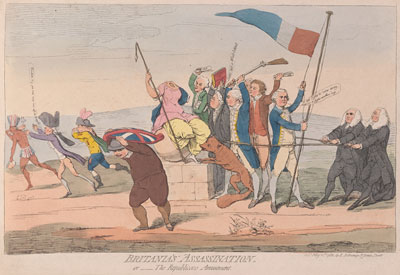Britania's Assassination,
or the Republicans Amusement
Britania's Assassination can best be viewed as a sequel to Gillray's undated Guy Vaux (which is likely to have been created in late March or early April of 1782) and as Gillray's view of the state of the nation a month into the new Rockingham administration. Many of the same "conspirators" featured in Guy Vaux, intent on blowing up the administration of Frederick, Lord North over what they viewed as his disastrous handling of the American war, are now shown, along with America and its allies—France, Spain, and Holland— actively attacking and dismembering Britannia, symbol of Britain.

© Yale University Library
The assailants include (front and center) Charles James Fox (the fox), and (from left to right) John Wilkes, John Dunning, Charles Lennox, Edmund Burke, and Augustus Keppel—all but Wilkes part of the new Rockingham Administration.
Charles James Fox, now Secretary of State for Foreign Affairs, is portrayed as a vicious fox seemingly determined to leave Britain without a leg to stand on in her negotiations with her enemies as he bites into one of Britannia's two remaining limbs.
Behind Fox and identified by a volume of the No[rth] Br[itain] (under his arm) Wilkes attacks Britannia with a scroll labeled Libel just as he attacked the King in the pages of that radical publication in 1762 (and was prosecuted for seditious libel).
Next to Wilkes, John Dunning, (Lord Asburton) now Chancellor of the Duchy of Lancaster, and an ardent supporter of American independence, takes a two-handed approach against Britannia. With both arms raised, he is about to slam her with a weighty volume of "Sydney on Government." Algernon Sydney was a politician and political philosopher in the time of Charles II, who, in his Discourses Concerning Government argued against the divine right of Kings and declared "the right of citizens to alter or abolish a corrupt government" as, in effect, the Americans were doing. Dunning himself was best known for the Sydney-like assertiom that "the influence of the crown has increased, is increasing, and ought to be diminished."
Next to Dunning, Charles Lennox, with rifle upraised, appears ready to strike Britannia with its butt end, intending, as he says to "Leave not a Wreck behind" His choice of weapons is ironically appropriate for a man who had just taken over the position of Master-General of the Ordnance.
Behind Lennox, Edmund Burke, now Paymaster of the Forces, is shown as in the 1769 portrait by Joshua Reynolds without his usual (and more familiar) spectacles. His attack is in the form of a "Reformation Bill" which probably refers to the several bills that grew out of his 1780 Speech on Economical Reform, including the Paymaster General Act of 1782 and the Civil List and Secret Service Money Act (1782) which abolished over one hundred offices in the royal household and civil lists and put constraints on the granting of pensions.
Finally, Augustus Keppel, who had now become First Lord of the Admiralty in the new administration, is shown taking down the British Colors with the self-serving couplet:
He that Fights & runs away,
May live to fight another day."
to explain his actions in the first Battle of Ushant (1778).
Although it was still too early to know exactly what concessions the Rockingham administration would make to America and its allies to put an end to the war, Gillray clearly believed that the result would be nothing short of disastrous for Britain. Now that Fox and Rockingham are in charge, Britannia is shown headless, with a broken spear and without her shield which is being stolen by Holland. Spain carries off a leg. And America is shown as an Indian chief running off with a head (which looks suspiciously like King George's rather than Britannia's) and an arm with a hand grasping an olive branch while a thin and foppish France runs behind complaining. As the British Museum commentary notes, this detail accurately predicted that America would make its own peace with Britain without including France.
The only hindrance to this wholesale looting and vandalism from within and without is the attempt by two men in robes, who are trying pull the attackers away from Britannia and thereby limit the damage. These are probably the two holdovers from the North admninistration—Henry Dundas (Lord Advocate) and Edward Thurlow (Lord Chancellor).
Taken as a whole, the print is a good example of Gillray's early style which relied on traditional stereotypes in the portrayal of America and its allies, and mini-portraits (not caricatures) to portray most of the members of the Rockingham administration. At this stage of Gillray's career, these mini-portraits can usually be traced to a well-known serious portrait of the subject, often by Reynolds.
Sources and Reading
- Commentary from the British Museum on Britania's Assassination, or the Republicans Amusement.
- Draper Hill, Mr. Gillray The Caricaturist, 1965, p. 23
- Nicholas K Robinson, Edmund Burke: A Life in Caricature, 1996, p. 36-7,
- "Britannia," Wikipedia
- "Edmund Burke," Wikipedia
- "John Dunning, 1st Baron Ashburton," Wikipedia
- "Charles James Fox," Wikipedia
- "Augustus Keppel, 1st Viscount Keppel," Wikipedia
- "Charles Lennox, 3rd Duke of Richmond," Wikipedia
- "Frederick North, Lord North," Wikipedia
- "William Petty, 2nd Earl of Shelburne," Wikipedia
- "Charles Watson-Wentworth, 2nd Marquess of Rockingham," Wikipedia
- "Second Rockingham ministry," Wikipedia
- "John Wilkes," Wikipedia
- "Algernon Sidney," Wikipedia
- "Peace of Paris (1783)," Wikipedia
- Thomas Wright and Joseph Grego, The Works of James Gillray, the Caricaturist; With the History of His Life and Times, p. 35.
Comments & Corrections
NOTE: Comments and/or corrections are always appreciated. To make that easier, I have included a form below that you can use. I promise never to share any of the info provided without your express permission.